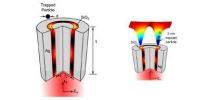(Press-News.org) UC Davis chemists have been using a Japanese synchrotron to get a detailed look at enzymes that could help power the green economy. The work was published online Nov. 8 by the journal Angewandte Chemie and is featured on the cover of the Nov. 26 issue.
One option for powering clean, environment friendly vehicles is to run them on hydrogen fuel rather than carbon-based fuels. Cheap catalysts to prepare hydrogen gas (H2) are key to this future "hydrogen economy."
Current man-made catalysts are based on the rare and precious metal platinum. But living cells contain enzymes called hydrogenases, based on the abundant metals nickel and iron, which can do the same job. Chemists are very interested in figuring out how these natural catalysts work and trying to mimic them.
Saeed Kamali, a postdoctoral researcher at UC Davis and Stephen Cramer, professor of chemistry have just published a study revealing new details of the iron-nickel complex at the heart of the natural hydrogenase. In collaboration with researchers at the Max Planck Institute in Germany and in the U.S., they used a technique called Nuclear Resonance Vibrational Spectroscopy (NRVS) and the SPring-8 synchrotron at the Japan Synchrotron Radiation Research Institute to probe the crystals and discovered new information about how the atoms in the complex can move.
###The work was funded by grants from the National Institutes of Health, the U.S. Department of Energy, and the Max Planck Society.
Synchrotron gives insight into green energy enzymes
2012-12-05
ELSE PRESS RELEASES FROM THIS DATE:
Predicting, preventing, and controlling pandemics: Making the case for a strategic action plan
2012-12-05
December 4, 2012 – About 60% of infectious diseases are caused by viruses, bacteria and other pathogens that make the jump to humans from other species. This includes some of the most devastating disease outbreaks of the past 30 years, including HIV/AIDS, Ebola, and SARS. Despite the huge and rising toll of such diseases, many gaps remain in our understanding of how these "zoonoses" evolve, develop, and spread—gaps that must be filled if we are to succeed in preventing or at least reducing the impact of a next pandemic.
A new paper published in the Lancet by Stephen ...
Climate models project increase in US wildfire risk
2012-12-05
Scientists using NASA satellite data and climate models have projected drier conditions likely will cause increased fire activity across the United States in coming decades. Other findings about U.S. wildfires, including their amount of carbon emissions and how the length and strength of fire seasons are expected to change under future climate conditions, were also presented Tuesday at the annual meeting of the American Geophysical Union in San Francisco.
Doug Morton of NASA's Goddard Space Flight Center in Greenbelt, Md., presented the new analysis of future U.S. fire ...
Longer life expectancy, aging population necessitate new strategies for prostate cancer care
2012-12-05
The population of the United States is getting older, due not only to aging boomers but also to a four-year increase in life expectancy from 1990 to 2010. An aging population means increased diagnosis of prostate cancer. Statistically, the older the patient at time of diagnosis, the more aggressive the disease – and also the less well the patient is likely to tolerate traditional chemotherapies. In sum, we have more, aggressive prostate cancer that can't be targeted by traditional treatments.
Members of the University of Colorado Cancer Center recently published a review ...
UI researchers help find way to protect historic limestone buildings
2012-12-05
Buildings and statues constructed of limestone can be protected from pollution by applying a thin, single layer of a water-resistant coating.
That's the word from a University of Iowa researcher and her colleagues from Cardiff University in a paper published in the journal Scientific Reports, from the publishers of Nature. In the study, the researchers report a new way to minimize chemical reactions that cause buildings to deteriorate, according to Vicki Grassian, F. Wendell Miller professor in the UI departments of chemistry and chemical and biochemical engineering.
The ...
Are there racial disparities in osteoporosis screening and treatment?
2012-12-05
New Rochelle, NY, December 4, 2012—About 30 million women in the U.S. have osteoporosis, with low bone mass and deteriorating bone structure that increases their risk for fractures. Racial differences in the rates of detection and management of osteoporosis were explored in a study of African American and white women published in Journal of Women's Health, a peer-reviewed publication from Mary Ann Liebert, Inc., publishers. The article is available free on the Journal of Women's Health website at http://www.liebertpub.com/jwh.
The study, "Osteoporosis Health Care Disparities ...
Quantum thermodynamics
2012-12-05
No man is an island, entire of itself, said poet John Donne. And no atom neither. Even in the middle of intergalactic space, atoms feel the electromagnetic field---also known as the cosmic microwave background---left over by the Big Bang. The cosmos is filled with interactions that remind atoms they are not alone. Stray electric fields, say from a nearby electronic device, will also slightly adjust the internal energy levels of atoms, a process called the Stark effect. Even the universal vacuum, presumably empty of any energy or particles, can very briefly muster virtual ...
Hogging the spotlight: South Farms pig gets international attention
2012-12-05
URBANA – A detailed annotation of the genome of T.J. Tabasco, a pig from the University of Illinois South Farms, is the outcome of over 10 years of work by an international consortium. It is expected to speed progress in both biomedical and agricultural research. U of I Vice President for Research Lawrence Schook said that the College of ACES played a crucial role in getting the work started.
Funding that came through ACES allowed Schook and others to put together the Swine Genome Sequencing Consortium, an alliance of university, industry, and government laboratories ...
New optical tweezers trap specimens just a few nanometers across
2012-12-05
To grasp and move microscopic objects, such as bacteria and the components of living cells, scientists can harness the power of concentrated light to manipulate them without ever physically touching them.
Now, doctoral student Amr Saleh and Assistant Professor Jennifer Dionne, researchers at the Stanford School of Engineering, have designed an innovative light aperture that allows them to optically trap smaller objects than ever before – potentially just a few atoms in size.
The process of optical trapping – or optical tweezing, as it is often known – involves sculpting ...
Brain stimulation may buffer feelings of social pain
2012-12-05
Paolo Riva of the University of Milano-Bicocca and colleagues wanted to examine whether there might be a causal relationship between activity in the right ventrolateral prefrontal cortex (rVLPFC) – known to be involved in the regulation of physical pain and negative expressions of emotion – and experiences of social pain. Their findings are published in Psychological Science, a journal of the Association for Psychological Science.
The researchers recruited 79 university students to take part in a "mental visualization exercise." They used a constant-current regulator ...
Antiretroviral treatment for HIV reduces food insecurity, reports AIDS Journal
2012-12-05
Philadelphia, Pa. (December 4, 2012) – Can treatment with modern anti-HIV drugs help fight hunger for HIV-infected patients in Africa? Starting antiretroviral therapy for HIV reduces "food insecurity" among patients in Uganda, suggests a study published online by the journal AIDS, official journal of the International AIDS Society. AIDS is published by Lippincott Williams & Wilkins, a part ofWolters Kluwer Health..
Treatment including antiretroviral therapy (ART) may lead to a "positive feedback loop" whereby improved functioning and productivity lead to increased ability ...



